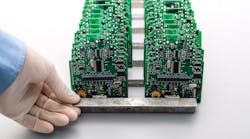Every generation of audio amplifier is designed to pump out louder and clearer sounds. They are also tapped to consume less power and better protect against failures due to high temperatures or mechanical faults. But as the space for audio systems inside speakers, smartphones and other devices shrink, companies ranging from Qualcomm to Texas Instruments have started to plug signal processing directly into amplifier ICs.
Audio amplifiers are designed to boost audio signals while preserving its detail. Today, the audio amplifier space is dominated by digital devices that integrate a number of discrete components that typically surround linear and other analog amplifiers. Many analog chip manufacturers have also started to add DSPs and other ICs to adjust the amplifier's performance based on feedback from the physical speaker and a stored model of speaker performance.
Last month, Qualcomm announced its latest smart audio amplifier based on its digital DDFA technology targeting stereo speakers inside soundbars and other products. Qualcomm, the largest supplier of smartphone chips, said that the CSRA6640 offers clearer and louder audio than linear and analog amplifiers. It integrates a DSP and Class-D amplifier that delivers up to 20W per channel. The chip can also bridge the output drivers to create a single 40W amplifier.
The San Diego, California-based company said that the chip integrates the output component that feeds audio into the speaker, which helps to cut development costs for customers. The chip responds to changes in the speaker's output to protect against failures while preserving low-noise, low-distortion and high-dynamic range audio. The amplifier IC also matches the performance of its last-generation CSRA6620, which requires a separate output driver.
“This solution opens the door for OEMs to help them bring more power efficient amplification capabilities to more compact, cost-effective devices,” Rob Saunders, product marketing manager at Qualcomm, said. The Class D amplifier inside dissipates less heat, draws less power and is smaller than Class A, Class B and Class AB linear amplifiers, which supply a continuous output current. Class D devices operate by switching rapidly between supply rails.
Class D amplifiers are designed to keep audio signals digital from input to output, preserving the integrity of the signal and enabling higher efficiency than Class A, AB and B devices. These audio amplifiers can achieve energy efficiencies above 90% by eliminating the use of linear gain devices and other analog components, which drive up the power dissipation of linear amplifiers. Nevertheless, the Class D amplifier is not without its shortcomings.
Class D devices are more sensitive to electromagnetic interference, which can dampen audio performance compared to linear amplifiers. As a result, Qualcomm and other suppliers have started to sell smart audio amplifiers that integrate DSPs and Class D devices to enhance audio while preventing overheating. They also aim to prevent the amplifier from supplying too much power to the physical speaker’s driver, which can lead to thermal failures.
Cirrus Logic, one of the largest suppliers of audio amplifiers used in smartphones, has also started to integrate DSPs into its Class D devices. The company introduced its first 55-nanometer smart audio amplifier last year. The part is not only smaller but also delivers clearer and louder audio than its last generation of chips. Last month, Cirrus Logic started selling its latest boosted audio amplifier, the CS35L41, which it says is 50% smaller than rival ICs.
Cirrus Logic's latest chip uses an advanced power management system and advanced algorithms to adapt to changing audio, speaker and battery conditions in smartphones and other portable devices. The system serves to curb power consumption without diminishing audio performance, it said. Austin, Texas-based Cirrus Logic is trying to enhance its line of audio amplifiers to grow its customer base and reduce its delicate dependence on Apple.
“More and more consumers are turning to their smartphone as a primary device for video streaming, gaming and listening to music—including using speakerphone or loudspeaker mode,” said Carl Alberty, the company's vice president of mixed signal products, in a statement. Cirrus Logic sees audio amplifiers sales growing as the demand for stereo sound increases in high-end smartphones and mid-level mobile devices that sell between $200 and $500.
Shipments of audio devices—and the number of audio channels per device—have continued to grow over the last decade. Audio amplifier IC shipments in the fourth quarter of 2018 were three times the total in the fourth quarter of 2010, according to market researcher SAR Insight. Peter Cooney, principal analyst at SAR, estimates that 700 million such amplifiers will be used in mid-tier smartphones by 2022, up from around 500 million in 2017.
Texas Instruments, the largest supplier of analog semiconductors, last year introduced a line of smart audio amplifiers for use in voice-controlled devices. The Class D amplifiers are all currently shipping in volume. The first product, the TAS2770, boosts the loudness and clarity of audio while consuming 15W. The amplifier IC monitors the physical speaker’s output and uses its unique audio processing algorithms to deliver richer audio, Texas Instruments said.
The chip combines a digital microphone input with a current sense amplifier to capture ambient acoustic information, which can be used to cancel out echoes. That enables its customers to add voice command capabilities without altering audio system design. The chip is also designed to protect against clipping, which occurs when the amplifier attempts to deliver a higher-than-possible output voltage or current. That can result in audio playback issues.
The second amplifier, the TAS5825M, delivers dedicated serial audio interface information to the applications processor, which can use it to support echo cancellation. The energy-efficient device also offers thermal protection by adding real-time, accurate voltage and current sensing, Texas Instruments said. The TAS3251 is an integrated digital-input device that supports higher performance and output power than the other members of the audio amplifier family.

